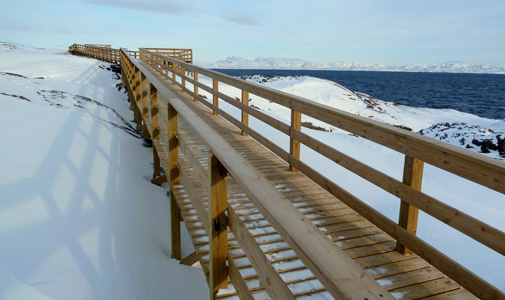
Frank Sejersen
Maniitsoq, Greenland, February 2011
It is difficult really to apprehend the town of Maniitsoq properly. Houses climb up and down the hilly landscape on the island and one just has to turn around a small hill to find a new part of town appearing. In order to understand the town’s anatomy I spend a couple of hours walking the snowy streets, on my arrival. The town has about 2700 inhabitants and is lying between the two bigger towns Sisimiut and Nuuk on the west coast of Greenland. Nearly from every house I could see the sea which has provided the inhabitants with resources to make the town prosperous. Whales, seals, Atlantic cod and shrimps are just some of the important species. Now, times have changed and the town’s fishing industry has collapsed due to changes in sea temperature and decisions taken by the national fishing company. There were no foot prints in the snow outside the fish factory and it was very silent. On my way through town I happened to pass by a wooden construction that lead me to a platform. From a distance it looked like a snake crawling on the rocky coastline. Standing on the platform I got a fantastic overview of the sea and the coastline. A local nurse took a break next to me and we took the time to small-talk. She explained that it is a good spot for whale watching and she often visits the place. Later, my conversations with people revealed that this wooden construction has a highly symbolic significance for the civil movement that is thriving in town. A number of active citizens’ groups are making suggestions to the municipality of how to improve the good life in town. This construction is one of their suggestions. Maniitsoq has been chosen as a site for an aluminum smelter and many hope that it will save it from turning into a ghost town. Unfortunately, the town experiences increasing unemployment and out-migration. Many talk about the brain-drain and the lack of critical mass which have pushed Maniitsoq away from its former central position in Greenland. People are waiting for the final governmental decisions to be taken and for the construction to start. But the deadlines are being pushed all the time as a lot of questions need to be solved before this billion dollar project can be implemented. It is going to be the biggest investment in Greenland ever and it will use water from the melting ice cap for hydro electricity to power the plant. The plant and the town is entangled in the climate change discussions in many ways not only because it turns melting ice into energy to trigger hyper-industrialization in Greenland but also due to the pollution from the plant that will nearly double the CO2 emissions of the country. Many people I interviewed related the development of the town to global processes – but in quite different and very meaningful ways. Among other things they considered this factory powered by green energy one way to reduce the global emissions because an alternative location (e.g. in China) would require a more polluting energy resource. They are reinventing their position within a changing world and this understanding is also reflected in the wooden platform. It was constructed – I was told – to “put Maniitsoq back on the map”.
